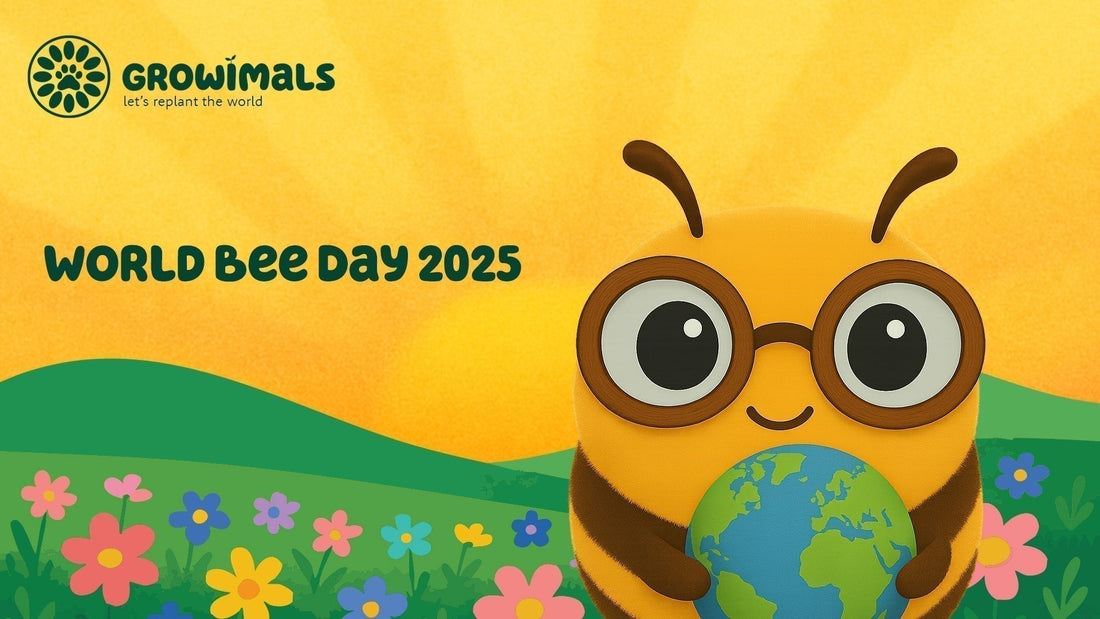
Why World Bee Day Is the Perfect Time to Plant Wildflowers with Kids
Share
Did you know that almost 90% of wild plants — and a third of the world’s food crops — rely on pollinators like bees? These fuzzy little wonders are some of the hardest-working creatures on the planet. And yet, their world is getting harder.
"Almost 90 percent of the world’s flowering wild plants (approximately 308, 000 species) depend, to varying degrees, on pollinators for their reproduction"
That’s why every year, on 20th May, we celebrate World Bee Day — a global moment to stop, smile, and think about how we can all help the bees.
At Growimals, we believe the best place to start is with kids, a few seeds, and a patch of soil. Here’s why...
What Is World Bee Day? Why Bees Deserve a Party!
World Bee Day was launched by the United Nations in 2018 to shine a spotlight on the essential role bees and other pollinators play in keeping our planet blooming — quite literally.
Pollination is essential for the world's food supply, supporting the production of more than 75 percent of the world's crops, including fruits, vegetables, nuts and seeds. In addition to increasing crop yields, pollinators improve food quality and diversity.
More than 200,000 animal species are pollinators, the vast majority of which are wild, including butterflies, birds, bats and more than 20,000 bee species. Without them, supermarket shelves would be emptier, gardens duller, and the natural world much, much quieter.
But bees are under threat — from habitat loss, pesticides, disease, and climate change. That’s why World Bee Day matters. It’s not just about bees. It’s about food security, biodiversity, and looking after our planet.
World Bee Day 2025 Theme: Bee Inspired by Nature to Nourish Us All
This year’s World Bee Day theme, “Bee inspired by nature to nourish us all,” highlights the essential roles that bees and other pollinators play in sustaining our ecosystems and food systems.
"About three quarters of the food we eat depend, at least in part, on pollinators."
By planting wildflowers with your children, you’re not only creating a fun and educational activity but also contributing to the restoration of pollinator habitats. This simple act supports the health of our planet and helps ensure a diverse and nutritious food supply for future generations.
Why Wildflowers Are a Lifeline for Bees
You’ve probably heard that planting wildflowers is one of the best things you can do to help bees — but have you ever wondered why?
It’s simple: wildflowers are like bee cafés. They offer nectar (a sugary energy drink) and pollen (a protein-packed bee snack). The more we plant, the more fuel bees have to keep buzzing — and pollinating the plants we rely on.
But here’s the sting in the tale: 97% of the UK’s wildflower meadows have vanished since the 1930s. That’s millions of lost lunches for pollinators.
The good news? We can start bringing them back — one seed, pot, or patch at a time.
Gardening with Kids - Big Change Can Come from Little Hands
There’s something magical about seeing a child's reaction when seeds they have planted suddenly start sprouting to life.
Planting wildflowers with children isn’t just a fun, muddy adventure (though it definitely is that). It’s also:
- A brilliant way to teach patience and care
- A chance to connect with nature, together
- An introduction to big ideas — like pollination, biodiversity, and protecting our planet
You don’t need a garden. A windowsill, balcony box or recycled tub will do just fine. And there’s no perfect way to do it. Scatter, water, wait — and let the wild take care of the rest.
When and How to Get Planting
If you’re in the UK, mid to late May is an ideal time to sow wildflower seeds — especially annuals, which bloom quickly and bring an instant buzz of colour. But you can plant wildflower seeds most times of the year. In the winter you'll just need to watch them germinate inside instead.
Here’s a super-simple way to get started:
- Grab a container (or clear a patch of soil outside).
- Sprinkle your seeds over damp, bare soil.
- Water gently — and keep the soil moist while they germinate.
- Wait for shoots — sprouts will usually appear within 1–3 weeks.
Want to get creative? Let your child name their patch, design a pollinator sign, or keep a “bee diary” to track visitors.
A New Family Tradition: Planting on World Bee Day
In a world full of noise and screens, planting a seed is a small act of stillness. It’s a way to connect with nature and grow something beautiful together.
This World Bee Day, we’re encouraging families everywhere to make wildflower planting part of their spring routine. You don’t need expertise, fancy gear or a massive space. Just a little time, some soil (and patience).
Let’s turn our balconies, windowsills, gardens, and playgrounds into tiny pollinator pit stops — and teach children that even the smallest actions can make the biggest difference. Let's replant the world together.
P.S. Meet the Growimals
If you’re looking for a fun way to help children connect with nature, meet the Growimals — a crew of seed-loving, planet-protecting animal characters on a mission to help kids rewild the world.
Our first Growimals seed kit (our Bee Booster Pack) launches on World Bee Day 2025, packed with wildflower seeds, fun activities, and a few surprises from the Petalheads (yes, including a wonderful bee... me! Fuzz Bloomblebee, Chief Environment Officer (CEO) of Growimals).

